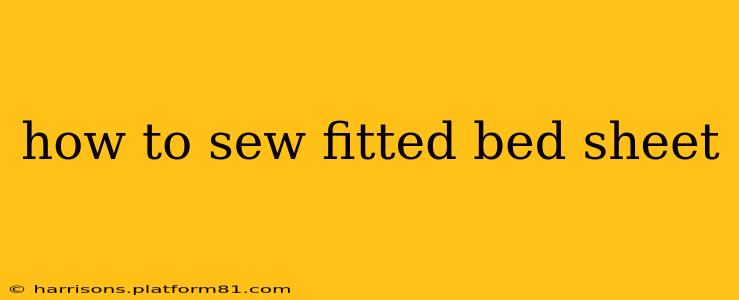Sewing your own fitted bed sheets might seem daunting, but with the right instructions and a little patience, it's a rewarding project that can save you money and provide custom-fit bedding. This guide will walk you through the entire process, from choosing the right fabric to finishing the final stitch. We'll even address some frequently asked questions to ensure you're completely prepared.
What type of fabric is best for fitted sheets?
The best fabric for fitted sheets is one that's durable, breathable, and comfortable. Percale, a tightly woven cotton, is a popular choice for its crisp feel and durability. However, you can also use other cotton blends, such as jersey knit for a softer, more stretchy feel. Consider the thread count – a higher thread count generally means a smoother, softer, and more durable sheet. Avoid fabrics that are too loosely woven, as they might be prone to tearing during use.
How do I measure for a fitted sheet?
Accurate measurements are crucial for a well-fitting sheet. You'll need to measure the mattress's length, width, and depth (height). Add extra fabric to accommodate the elastic casing and the snug fit. For example, add about 1-2 inches to each measurement beyond the dimensions of the mattress itself. Consider the depth of your mattress: deeper mattresses will require more fabric for the casing.
What is the best way to measure a mattress for a fitted sheet?
The best way to measure is to use a flexible tape measure and measure along the longest side, the shortest side, and then measure the height of your mattress from the base to the very top. Double-check each measurement to ensure accuracy. Consider measuring the depth in several places, as some mattresses might have slight variations in height.
How much fabric do I need for a fitted sheet?
The amount of fabric needed depends on the size of your mattress and the type of fabric you're using. A general rule of thumb is to add approximately 12-18 inches to each measurement (length and width) for the casing to allow for ease of fitting and the elastic. For the height (depth), you will need at least twice the depth of your mattress to allow for the casing and the folds needed to encase the elastic. It's always better to have slightly more fabric than less.
What size should the fabric be for a king size fitted sheet?
For a king-size fitted sheet, you'll need significantly more fabric than a smaller sheet. The measurements will depend on the exact size of your mattress but generally plan for several yards of fabric, taking into account the addition of extra fabric for the casing. Again, consult the cutting instructions based on your mattress measurements to determine the exact amount of fabric needed.
How do I sew elastic into a fitted sheet?
Sewing in the elastic is a key step. You will typically create a casing (a folded-over edge) along the perimeter of the sheet, then insert the elastic. You can either sew the elastic to the casing before inserting it or insert it and then sew the casing shut. Using a zig-zag stitch is recommended to prevent the elastic from stretching or breaking.
What kind of elastic should I use for a fitted sheet?
Use a strong, wide elastic that's appropriate for the size of your mattress. 1/4" or 3/8" wide elastic is commonly used. Choose a high-quality elastic designed to withstand repeated stretching.
How to sew the corners of a fitted sheet?
The corners are crucial for a snug fit. The most common method involves creating a diagonal seam at each corner, then encasing the elastic within this corner. This creates a smooth, secure fit. Consider using a mitered corner technique for a cleaner finish. There are several online tutorials showing different corner techniques for fitted sheets.
What are some tips for sewing fitted sheets?
- Pre-wash your fabric: This prevents shrinkage after the sheet is sewn.
- Use sharp needles and pins: This will make sewing easier and more precise.
- Take your time: Rushing can lead to mistakes.
- Test your stitch: Do a test seam on a scrap piece of fabric to ensure you have the right tension and stitch length.
- Iron your seams: This will create a neater, more professional-looking finish.
By following these steps and tips, you can successfully sew your own fitted bed sheets, creating custom-fit bedding that perfectly matches your preferences and your mattress. Remember, practice makes perfect! So don't be discouraged if your first attempt isn't flawless. Enjoy the process and the satisfaction of creating something beautiful and functional for your bedroom.
